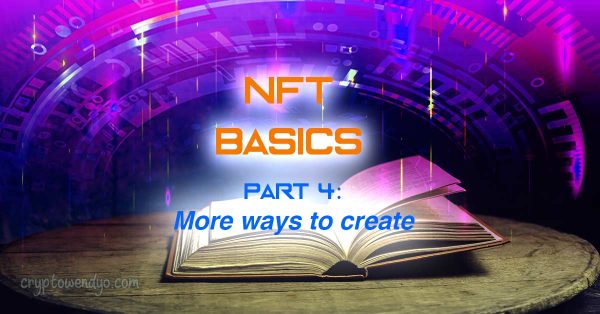


If you’re just now joining us in our series on NFTs…why? Part Four is a strange place to start. Maybe go back & read parts One, Two, and Three to catch up.
If not, this is probably the point where it stops being “back to basics” and starts being stuff you may not have seen, yet.
In cryptocurrency, we often find ourselves on the cutting, if not the bleeding-edge of technology. This is definitely the case when it comes to both non-fungible tokens and artificial intelligence.
If you thought things were complicated when the pitch was as simple as, “Art on the blockchain”, then how murky are the waters as we see a deluge of “art” that requires very little human interaction in order to exist?
For instance, the above pictures only required me to prompt an AI for a cyberpunk rendering of “Crypto Wendy O” in the style of Hajime Sorayama. While I don’t think they had enough images of Wendy for the AI to have learned her features for use with prompts, specific training or customized models can have much more directed accuracy.
Regardless, as someone who isn’t an art student…can I distinguish the above works from those of an actual artist? If I’m being honest? No. For more specific things, it would be really hard to impart the creative processes an artist might go through, but with enough fine-tuning of prompts & methods, you can get awfully close.
A lot of these software developers include lines in their Terms of Service stating unequivocally that the resulting art shouldn’t be used for NFTs. AI Curio Bot is a great example of this, with it clearly stated in the bio. Some ‘creators’ will still be tempted to subvert the rules, but there are just as many models like Midjourney that allow commercial use with the proper paid subscription.
This has brought up an interesting debate: is there value in crafting prompts that result in more beautiful or appealing art? It also brings to mind questions of ‘sampling’, much like the early days of hip-hop, where artists would frequently “sample” beats from another artist’s work.
Because, in a way, that is what the AI is doing. It is sampling or learning from untold petabytes of images in order to create something as stylistically similar to your prompts as it can manage.
However these debates shake out, you should be aware of the emerging trends in AI & art-related tech if you’re purchasing NFTs. Here’s an “oily otter” NFT the Midjourney AI tossed out after about a minute of waiting. Food for thought.
Since we’re already discussing the ways that the art has become easier, I thought it might be a good time to discuss how the contracts & minting processes are getting easier.
Way back in Part Two we went over everything required to create a NFT collection on Opensea, and then covered how to ‘mint’ individual NFTs to add to it.
That isn’t the same as “minting”, though. Not really. Most folks are used to going on a collection’s website, connecting their wallet, and minting. Then they wait a few minutes & see what they end up with in their wallet.
In the past, you’d need to know a fair bit about websites & writing contracts in order to launch your collection this way.
Now? With platforms like Ambition, most of the functionality that would’ve required months of experience or a developer is now pretty much as easy as entering the values you want when prompted.
Full disclosure; Ambition isn’t a sponsor; I just think they have an attractive platform, and anything that makes contract deployment easier & less prone to exploits is worth a look, to me.
I won’t go into a tutorial, but you can visit the link above if you’re interested in seeing more.
In short, you can create the minting contract & related variables, and launch a minting website from scratch or a template – and connect the contract to it for web3 connectivity. They offer multiple other add-ons, such as hosting images via their IPFS pinning service at a cost of $20/month, and pricing plans for the other services vary or include a % of whatever you raise.
Despite the bear market, it has actually never been easier to create a NFT. Which could be part of why we’re seeing so many failed launches & false starts, aside from the usual rugs & exit scams.
The usual cycle tends to see cash-grabs, memes, and half-hearted attempts fall away so that by the time another bull market returns, you’re mostly left with the projects that have promise or staying power. Mostly.
It’s anyone’s guess if this will prove to be the case with NFTs; the vast majority may never find value, again. I’d wager that the ones that manage to survive the bear market will be those with slightly more innovation & sweat equity than two hours’ of AI prompts & filling in form data.
Until next time: make something new, and then ask yourself, “Would I buy this?”

Torrent/seedbox aficionado, decentralist, cultural archivist, fundamental analyst, podcast addict, shitcoin-sifter extraordinaire
Tip Jar
BTC: bc1qahxrp47hpguhx8y8r382dekgca34tlv54aufht
Doge: DJRy9gGSUGeyXfVcZXzKLkBv7RmDLv3MhJ
Share This Article
Join 10,000+ forward thinkers! Get crypto education in your inbox.